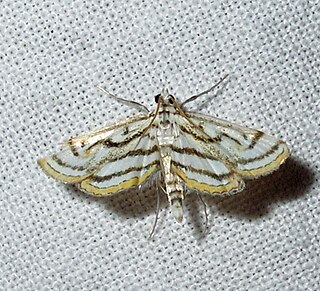
Parapoynx stratiotata, the ringed china-mark, is a moth of the family Crambidae. The species was first described by Carl Linnaeus in his 1758 10th edition of Systema Naturae. It is found in Europe where the distribution area extends in the north to the British Isles including Ireland and in the south to Sardinia, Sicily and Greece. The species is also found across the Palearctic in North Africa, Lebanon, Turkey, Azerbaijan, Kyrgyzstan, Uzbekistan and China..

Parapoynx is a genus of moths of the family Crambidae described by Jacob Hübner in 1825.

Parapoynx diminutalis is a species of moth of the family Crambidae described by Pieter Cornelius Tobias Snellen in 1880. It is endemic to south-east Asia, including the Northern Territory, Queensland and New South Wales in Australia, but has since been found in the United Kingdom and the United States. It is also found in Africa, where it has been recorded from Egypt, Sudan, Ethiopia, Kenya, Uganda, Tanzania, Zambia, Zimbabwe, Malawi, South Africa, Botswana, Angola, the Republic of the Congo, Nigeria and Madagascar.

Parapoynx fluctuosalis or Fluctuating China-mark or Waved China-mark, is a moth of the family Crambidae. It is a widespread species, known from Africa, India, Sri Lanka, China, Japan, Malaysia, Taiwan, Guam, Hawaii, Fiji, Australia and the Galápagos Islands. It is also an introduced species in Europe, where it has been recorded from Great Britain, the Iberian Peninsula and Sardinia.

Parapoynx allionealis, the watermilfoil leafcutter moth, is a moth in the family Crambidae. It was described by Francis Walker in 1859. It is found in North America, where it has been recorded from Alabama, Florida, Georgia, Indiana, Louisiana, Maine, Manitoba, Maryland, Massachusetts, Michigan, Minnesota, Mississippi, New Brunswick, New Hampshire, New Jersey, New York, North Carolina, Nova Scotia, Ohio, Oklahoma, Ontario, Quebec, South Carolina, Tennessee and Texas.

Parapoynx badiusalis, the chestnut-marked pondweed moth, is a moth in the family Crambidae. It was described by Francis Walker in 1859. It is found in North America, where it has been recorded from Illinois, Indiana, Iowa, Maine, Manitoba, Maryland, Massachusetts, Michigan, Minnesota, Nebraska, New Hampshire, North Dakota, Ohio, Oklahoma, Ontario, Pennsylvania, Quebec, Saskatchewan, Vermont and Wisconsin. The habitat consists of vegetated ponds, marshes and lakeshores.

Parapoynx crisonalis is a moth in the family Crambidae. It was described by Francis Walker in 1859. It has a wide range and has been recorded from India, Sri Lanka, Thailand, Indonesia, China, Taiwan, Japan and Australia (Queensland). It has been recorded from Great Britain through accidental import with aquatic plants.
Parapoynx medusalis is a moth in the family Crambidae. It was described by Francis Walker in 1859. It is found in São Paulo, Brazil and in Australia, where it has been recorded from Queensland.
Parapoynx polydectalis is a moth in the family Crambidae. It was described by Francis Walker in 1859. It is found in Indonesia, New Guinea and Australia, where it has been recorded from Queensland, northern Western Australia, the Northern Territory, New South Wales and Victoria. It is an introduced species in Great Britain and France.
Parapoynx seminealis, the floating-heart waterlily moth, is a moth in the family Crambidae. It was described by Francis Walker in 1859. It is found in North America, where it has been recorded from Florida, Georgia, Massachusetts, Mississippi, New Hampshire, Rhode Island, South Carolina and Texas.

Parapoynx tullialis is a moth in the family Crambidae. It was described by Francis Walker in 1859. It is found in Australia, where it has been recorded from the Australian Capital Territory.
Parapoynx affinialis is a moth in the family Crambidae. It was described by Achille Guenée in 1854. It is found in Egypt and from the Middle East to India. It has also been recorded from Australia.
Parapoynx bilinealis is a moth in the family Crambidae. It was described by Snellen in 1876. It is found in India and Japan. It has also been recorded from Europe, where it was accidentally introduced.
Parapoynx bipunctalis is a moth in the family Crambidae. It was described by George Hampson in 1906. It is found in Sudan, Uganda, the Democratic Republic of the Congo, Nigeria, Niger, Benin, Ivory Coast, the Gambia and Senegal.
Parapoynx euryscia is a moth in the family Crambidae. It was described by Edward Meyrick in 1885. It is found in Australia, where it has been recorded from Tasmania and Victoria.

Parapoynx maculalis, the polymorphic pondweed moth, is a moth in the family Crambidae. It was described by James Brackenridge Clemens in 1860. It is found in eastern North America, where it has been recorded from Alabama, Alberta, Florida, Georgia, Illinois, Indiana, Louisiana, Maine, Maryland, Massachusetts, Michigan, Minnesota, Mississippi, New Brunswick, New Hampshire, New Jersey, Newfoundland, North Carolina, North Dakota, Nova Scotia, Ontario, Pennsylvania, Quebec, South Carolina, Tennessee, Texas and Wisconsin. The habitat consists of ponds and streams.
Parapoynx ophiaula is a moth in the family Crambidae. It was described by Edward Meyrick in 1936. It is found in the south-eastern part of the Democratic Republic of the Congo and north-western Zambia.
Parapoynx plumbefusalis is a moth in the family Crambidae. It was described by George Hampson in 1917. It is found in Sudan, Uganda, Kenya, Tanzania, Zambia, Zimbabwe, Cameroon, Senegal, Nigeria, Niger, Sierra Leone, Angola, Botswana, Kenya and Madagascar.
Parapoynx zambiensis is a moth in the family Crambidae. It was described by David John Lawrence Agassiz in 2012. It is found in the Democratic Republic of the Congo, Botswana and Zambia.







